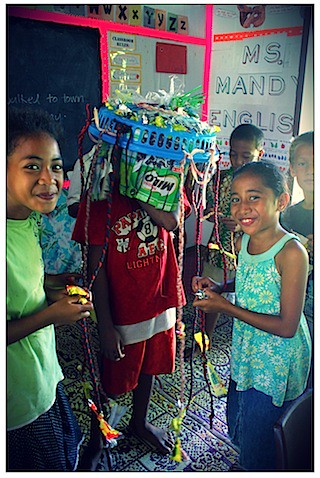Let's play the comparison game for a second. School in Tonga is a bit different than teaching in the States and while I'd like to compare the two for you, I can tell you what I won't do is tell you which one is better or worse. It's really like apples and oranges - just different. The following is based on how I set my classroom up in the States (so maybe the comparison could just be looking at my teaching styles in both cultures) and what Ms. Mandy's classroom looks like in Tonga. I'm going to try not to generalize too much, but this is what I've learned and what works. Alright. Let's take a look.

Respect & Names:
America: Students calls me Ms. Pederson - or Ms. P for short. This was primarily due to the fact that last-name usage was common practice in the majority of the school's I worked. I guess was looked at as being respectful to address teachers with Ms. or Mrs. and their last name. The entire time I was in the States I wished they could call me Ms. Mandy because my last name is hard to say and because Ms. P. well... it induces a lot of giggling if you are a nine-year-old boy. Ms. P? Ohhhhh Ms. Pee... I get it.
Tonga: First names are used only. Just the first name. Forget the Ms. or Mrs. or Mr.. Respect is still given despite the lack of Mr., Ms. or Mrs. This is the case at the Primary Level. I have yet to explore naming practices at the secondary or post-secondary level in Tonga.
Teaching Methods:
America: Much of the research coming out of the States talks about differentiation, teaching to student's various strengths and learning styles, and making the classroom a "student-centered" environment. This works in the States. It works in many other places in the world, too. I've seen it do wonders in the classrooms I worked in throughout Florida, Wisconsin and Colorado. For example: Walking into my classroom in Colorado during a literacy block, you might see many small groups, independent work, and group work with me. The students would all be working at their level and aside from mini-lessons about grammar, comprehension skills or something else that the district or state standards deem worthy, it is the little kids in the room driving what is being focused on and learned in the classroom.
Tonga: Tonga's new national primary school curriculum (which was adopted last year) promotes "student-centered" learning as well. I'm still on the fence as to whether the definition of "student-center" is different for different countries, or with this curriculum being new that the definition that the United States uses just hasn't been realized yet. Regardless, there are a lot of really good things happening in Tongan schools. What is primarily taking place in my school at this time involves teachers spending most of their time in front of the classroom and students spend a lot of their time doing rote memorization activities. These students are bright though - they pay attention to patterns and rhythms and it appears that learning is taking place. They do arts projects and are asked to share their findings with the teacher while other students listen in. My English classroom still uses small groups to facilitate learning, but is balanced with a mixture of songs, poems, and repetition. I see it working. I spend a little more time in front of the classroom vs. what I did in the States, too. Maybe a gradual release of responsibility will come later in the year, but for right now, this system is working out quite well.
Specials (extra-curriculars, art, music, PE, etc.):
At the primary level there are no separate classes for Art and Music, yet if you look and listen carefully you will see that Art and Music are infused into the general curriculum here. Both are used to teach every subject - music especially seems to be something that Tongan students gravitate towards and when break time rolls around you can almost be sure that you will hear some sort of singing outside. The two classes that students have outside of the general curriculum are PE and Creative Technology. PE is just like it in the States (with way less equipment and zero budget). Creative Technology fuses Tongan culture with technology. One day the students could be learning how to weave and the next learning to type on the computer. The GPS that I work at was chosen to pilot a technology project a few years ago. Because of this, I have "laptops" (which remind me a lot of the computers I learned how to type on back in 1992) which occasionally work to teach the students on. Really though, I'm teaching computers without computers, which is quite the task!
I know there are many more areas in school or themes that I could touch upon, but I wanted to just cover a few this time around! If there is something you are curious about, please let me know! (By commenting on this post or emailing me at beneathabalconyofstars(at)gmail(dot)com.)

In Korea my students tended to call me Laura Teacher or just Teacher because that's how they address all teachers (even doctors are referred to using the word for teacher). The classroom wasn't student-centered, but more of a collective style. I taught grades K-6 English which was so challenging for an undergrad like myself. I had a co-teacher for grades 3-6, which left me to teach the youngest kids alone. My biggest struggle there was getting the students to listen/calm down. Once I got the hang of it though I enjoyed teaching the younger students so much. They were more willing to do songs or art projects than the older kids were!
ReplyDelete